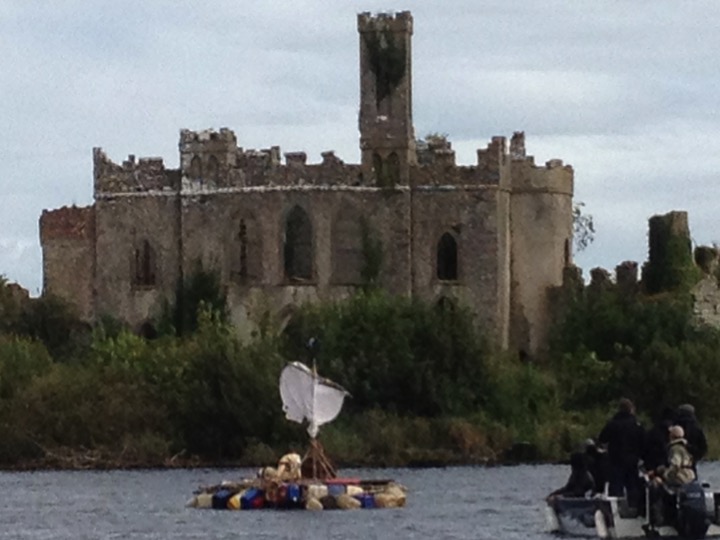Castle Island has passed through the ownership of two famous families the Mc Greevy’s and the Mac Dermots.
The island is sometimes referred to as The Rock to this day. We first hear of a castle Island when the Annals of Loch Cé report that it was burned down in 1187 by lightning. It is written in the Annals of Lough Cé (A chronicle of Irish affairs from A.D. 1014 to A.D. 1590) that Lady McGreevy haunts the Castle on Castle Island.
The castle featured in the final act of the conquest of Connacht in 1235, by Richard de Burgo whose army included 500 mounted knights. The castle came under siege, first by a raft-mounted perrier (catapult), and then by fire ships comprising wood stripped from the nearby town of Ardcarne.
The combination of rocks and flames proved too much for the castle garrison, forcing Cormac MacDermot, King of Moylurg to surrender.
The castle is mentioned frequently in the ancient annals, being a focus for both fighting and partying. A poem addressed to Tomaltach-an-einigh MacDermot (King of Moylurg 1421-58) tells the story of the Hag of Loch Ce who used Cormac MacDermot’s (1218-44) hospitality by staying on the Rock for a full year, and laid upon the MacDermot family the obligation of perpetual hospitality.
Brian of the Carrick, Chief 1585-92, is the last head of the clan who lived on the island.

A poem by Eochaidh O hEoghusa, written about 1600, laments the castle’s uninhabited and ruinous condition:
“…Thy bright fair form has changed, gone are thy gold-rich dwellings from thy fair comfortable long-walled enclosure, nor does the lime-white adorning of thy frontal remain…”
Lord Lorton built a folly castle in the early part of the 19th century, as one of the adornments to the estate whose centre piece was Rockingham House.
Isaac Weld, writing in 1832, describes as part of “the castle proper” 2 rooms, one above the other, each 36 feet by 22 feet, with walls of 7.5 feet thickness. It is not clear whether this refers to part of the original castle, or the later construction.
W.B. Yeats from Sligo was said to have visited the islands many parties visited Castle Island in 1890 and considered setting up an artistic centre there.
The folly castle, used as a summerhouse, was gutted by fire shortly before the Second World War.

Moone Boy, the Emmy Award-winning TV series, finds its esteemed residence in Boyle.
Moone Boy, the beloved TV series, found its captivating filming locations in the idyllic surroundings of Lough Key and the picturesque town of Boyle. The show’s production team discovered the enchanting beauty of Lough Key and decided it would be the perfect setting for some of the most memorable scenes in the series. With its tranquil waters and lush greenery, Lough Key provides a stunning backdrop that adds a touch of magic to the adventures of Martin Moone and his imaginary friend, Sean.
One notable feature of the show’s Lough Key scenes is the raft, a pivotal element created by Oliver Nevin of Lough Key Boats. This specially crafted raft becomes an integral part of Martin’s escapades, serving as a vessel for his imaginative journeys and bringing an element of whimsy to the show. Oliver Nevin’s craftsmanship and attention to detail in constructing the raft adds an authentic touch to the series, making the viewer feel fully immersed in Martin’s imaginative world.
As the story unfolds, the series also ventures into the charming town of Boyle, capturing its unique essence. Boyle’s quaint streets, historical buildings, and warm community atmosphere contribute to the overall charm of Moone Boy. Additionally, Boyle native and acclaimed actor Chris O’Dowd, known for his exceptional talent, brings an authentic connection to the show as he portrays the character of Martin’s father, providing a sense of familiarity and genuine representation of the town’s spirit.
With Lough Key’s ethereal beauty and the allure of Boyle’s vibrant community, Moone Boy succeeds in creating a truly enchanting and relatable world for its viewers. The combination of Chris O’Dowd’s portrayal, the captivating Lough Key scenes, and the contributions of local craftsmen like Oliver Nevin, elevates the series to a level of authenticity that resonates with audiences. Through this collaboration of talent and locations, Moone Boy captures the hearts of viewers, immersing them in a nostalgic and whimsical journey through the magic of Lough Key and the town of Boyle.